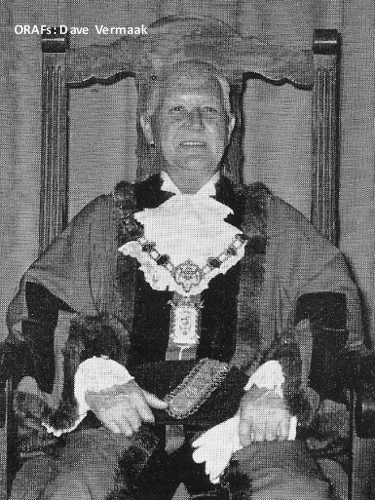(Pioneer and Pathfinder)
Although the word "pioneer" Is often overworked, it nevertheless epitomises the life and work of a man who learned to fly nearly forty years ago, and who did most of his flying in Central Africa. Captain J. A. C. Florence, who retires at the end of April, was one of that small but select band of pilots who, in the years between the wars, flew for Rhodesia and Nyasaland Airways—often over largely uncharted territory and with the barest of navigational aids.
Florrie, as he is affectionately known throughout (and far beyond) CAA, started his flying career in 1924, when he was appointed to a short-service commission in the RAF. On completing his service he, like many another, was foced with the problem of getting a foothold in a business world hard-hit by the trade depression of the early nineteen thirties. Following a series of unexciting and unrewarding jobs, during which he kept his hand in by doing what flying he could, he returned to Southern Rhodesia, where he joined RANA (Rhodesia and Nyasaland Airways).
Returned, did we say? Yes—he had been in these parts before. Originally intended for the Senior Service, and educated at RNC, Dartmouth, Florrie along with many another potential NO, had received the chop of the Geddes Axe, and he found himself on the beach. So in 1920 he came to Rhodesia as a pupil farmer under his brother, who at that time farmed near Marandellas. But three years later he was on his way back to England, travelling in what he describes as a "very stern fashion" in an old P and 0 ship at a steerage fare of £16 from Cape Town to London. This repatriation was the result of a serious bout of blackwater fever, from which he happily made a complete recovery. And so to the RAF—via the Wembley Exhibition, where he conducted VIP tours for the princely salary of 30/- a week while waiting for his papers to come through.
On the outbreak of war Florrie left RANA to join the SAAF, and soon become OC 61 Communications Squadron. At one time, he tells us, this squadron hod no less than 53 aircraft of 33 different types. One can well imagine the chcos of the spares position. He was also personal pilot to the Director-General of the SAAF. Later he was seconded to the RAF in Egypt on Fighter Operations Control, subsequently returning to South Africa to become Senior Operations Officer and assist in the formation of No. 1 1 Operations Training Unit.
On demobilisation, Florrie returned to civil aviation in Salisbury, his former employers having in the interim become CAA (Central African Airways)). He gave up active flying, though retaining his ticket for some while, and became Lines Supervisor. In 1951 came well-deserved promotion, when he was posted to Blantyre to take administrative charge of the Corporation's affairs in Nyasaland. During the twelve years he has spent in that territory he has not only seen great changes in the pattern of air travel, but also he has been very largely responsible for bringing them about. For example, in 1951 there were only two internal services a week out of Blantyre, and both of them to Lilongwe.
Now there are 1694 route- miles in the unduplicated network covered by feeder services within Nyasaland, the Beaver aircraft carrying 4,000 passengers a year in addition to freight and mails.
Captain Florence is best known to the people of Blantyre —and in fact throughout Nyasaland—for his devotion to public and civic duties. Both he and his wife have been very active in promoting all manner of voluntary schemes, and for these services he was awarded the O.B.E. in 1958. He served as Mayor for nearly five years and in his last year of office had the unique distinction of being the last Mayor of Blantyre and the first Mayor of Blantyre-Limbe, having handled the delicate negotiations which resulted in the amalgamation of the two townships. The great advances and improvements in street lighting, pavements and municipal parks are largely his doing. He served on countless boards and committees and amongst other activities he was chairman of the Chichiri School Board, for whom he acquired playing fields and the school hostel. The latter, appropriately and in recognition of his services, is named Florence House.
And so Florrie comes to the milestone which marks not the end of the road but the crossroads in the life of one who is most fittingly described as a pioneer and a pathfinder —a man who blazed the trail for others to follow. To him we wish good health and happiness in whatever sphere his future activities and interests may lie. And to Mrs. Florence, too, we send our very best wishes coupled with the sincere hope that a welcome change of climate will restore her to perfect health. We salute you, Florrie, and wherever your caravan may rest we say Happy Landings.
End
Dave Vermmak (Air Rhod.) Writes:-
Capt. Florence who was CAA Manager for Nyasaland. The 5 years I was there was an absolute privilege and joy with him as boss. The periodic route inspections with him piloting the Beaver to see how our handling agents were shaping at the route stations on the Blantyre / Mbeya route, with night-stops at Mzimba, Mzuzu and Fort Hill were occasions to remember for all times!
Extracted and recompiled by Eddy Norris from the SCAANER publicaton of April 1963 which was made available to ORAFs by Dave Vermaak (Air Rhod.) Thank you Dave
Comments are always welcome, please enter them below or mail them to Eddy Norris at orafs11@gmail.com and they will be loaded to ths article.
Suggested further reading.
http://rhodesianheritage.blogspot.com/2012/11/opening-of-dona-bridge-mozambique.html
http://rememberbeira.blogspot.com/
Ref. Rhodesian Aviation

No comments:
Post a Comment